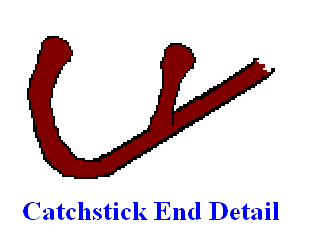By the Author of the Scrapboard : | |
|---|---|
 | Attack, Avoid, Survive: Essential Principles of Self Defence Available in Handy A5 and US Trade Formats. |
 | |
 | Crash Combat Second Edition with additional content. Epub edition Second Edition with additional content. Crash Combat Third Edition Epub edition Third Edition. |
 | |
 | |
 The form of the Catchstick will be that of a straight rod with a hook at each end. This will probably resemble a mathematical “Integer” sign although an alternate form resembling a long straight “C” is an alternative. Several inches below the hook will be a second branch which will be set at an angle of about 60° to the hook when the Catchstick is viewed end on. Each end of the Catchstick will therefore resemble a letter “ f ”. The straight section or shaft will be long enough to accommodate a grasp by both hands held at shoulder width and may be oval in section to facilitate grip. The hooks will have a radius of curvature sufficient to encircle an arm (probably 2¼ -2½”) and terminate in a teardrop shaped section. The mouth of the hook may be slightly narrower than the diameter and hooks that are slightly canted are also possible. Various means of construction are possible but a likely choice will be a spine of aluminum or thin steel tube covered by padding. The Catchstick will be of a light weight to discourage its use as a impact weapon.
The form of the Catchstick will be that of a straight rod with a hook at each end. This will probably resemble a mathematical “Integer” sign although an alternate form resembling a long straight “C” is an alternative. Several inches below the hook will be a second branch which will be set at an angle of about 60° to the hook when the Catchstick is viewed end on. Each end of the Catchstick will therefore resemble a letter “ f ”. The straight section or shaft will be long enough to accommodate a grasp by both hands held at shoulder width and may be oval in section to facilitate grip. The hooks will have a radius of curvature sufficient to encircle an arm (probably 2¼ -2½”) and terminate in a teardrop shaped section. The mouth of the hook may be slightly narrower than the diameter and hooks that are slightly canted are also possible. Various means of construction are possible but a likely choice will be a spine of aluminum or thin steel tube covered by padding. The Catchstick will be of a light weight to discourage its use as a impact weapon. Reading Erle Montaigue's article on Deerhorn knives the following passage struck me:-
Reading Erle Montaigue's article on Deerhorn knives the following passage struck me:-